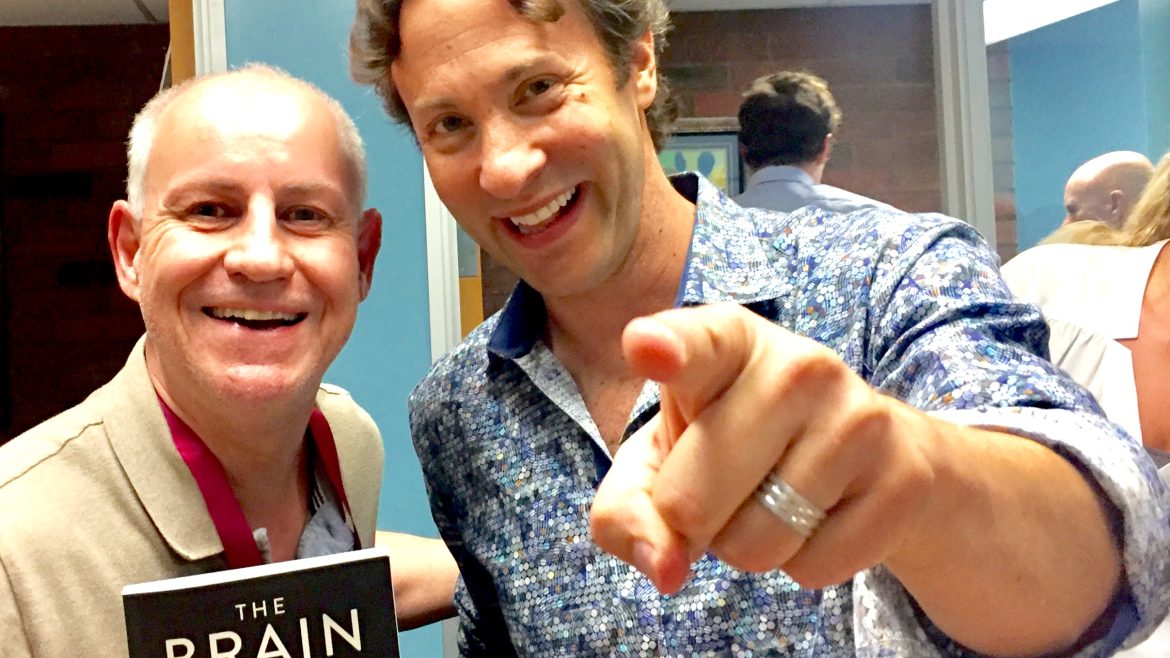Why do we dream?
This is a question that has eluded science for some time.
The answer is rooted in the incredible plasticity, or ability to change, of the human brain.
When we are born, we lack many abilities of other species. We can’t walk, we can’t eat solid food, we take many years to reach adulthood.
To do this, our brain is incredibly plastic. It can change very quickly in response to the information it receives.
David Eagleman is the leading researcher and communicator on brain plasticity – I met him in Los Angeles in 2017 at a conference on neurofeedback (photo above).
David explains in his book Livewired how this plasticity works. Our brains are neural networks, the most complicated structures in the universe, designed to make sense of the information they receive. Your brain lives in darkness inside your skull, yet it creates our sense of reality by making sense of the information it receives from your senses. This ability is entirrely dependent on neuroplasticity.
For example, your auditity cortex was not designed to be your auditory cortex. It became your auditory cotrex, because it was connected to your ears. This plasticity is fundamental to how our brains develop.
If you cannot see, but your other senses work well, they will naturally compensate, become stronger. The really interesting thing is they will become stronger by using the part of the brain that is normally used for sight. Studies1 have shown how in blind people, the part of their brain normally used for sight is taken over by other senses such as hearing, smell or touch, and even cognitive functions such as memory and language.
How long does this take? It happens remarkably quickly, scientists have shown this ‘takeover’ beginning within one hour of being blindfolded2.
So what happens when we go to sleep for 8 hours? Our sense of sight isn’t being used, so isn’t there a risk that other senses such as touch and hearing will take over our visual cortex, and when we wake up we won’t be able to see as well?
That is exactly the reason why David Eagleman believes we dream. We dream to keep our visual cortex active whilst we are sleeping, to protect it from being taken over by other functions.
It’s all explained in a 2021 journal article3. Eagleman and his collegaue have demonstrated that this explanation makes a lot of sense by comparing the brain plasticity of many prinates with the amount of dreaming they do. The more plastic => the more vulnerable the visual part of the brain is to ‘takeover’ => the more dreaming they do. `They also demonstarted that as humans get older, and our brains become less plastic, we do less dreaming.
If you are interested to hear David Eagleman talking about this and other mind-boggling applications of neuroplasticity, try this podcast (The first 5 minutes are adverts): https://tim.blog/2023/05/27/david-eagleman/.
Stuart Black, 2nd June 2023.
- Merabet, L. B., Swisher, J. D., McMains, S. A., Halko, M. A., Amedi, A., Pascual-Leone, A., et al. (2007). Combined activation and deactivation of visual cortex during tactile sensory processing. J. Neurophysiol. 97, 1633–1641. doi: 10.1152/jn.00806.2006
- Eagleman, D. M., & Vaughn, D. A. (2021). The defensive activation theory: REM sleep as a mechanism to prevent takeover of the visual cortex. Frontiers in neuroscience, 15, 632853.
